Paddle Steamer Waverley
|
These pictures were taken on an excursion in the early seventies.
Waverley was then part of the fleet of the Caledonian Steam Packet Company
(soubriquet of British Rail, who no doubt thought the name was more 'colourful'). Even in these pictures, you can see the signs of neglect - rust streaks everywhere and far too much oil smoke from the funnels (Waverley is oil-burning). We didn't mind - we just enjoyed the experience. There's something magical about a trip on a steam ship, particularly a Paddle Steamer. |
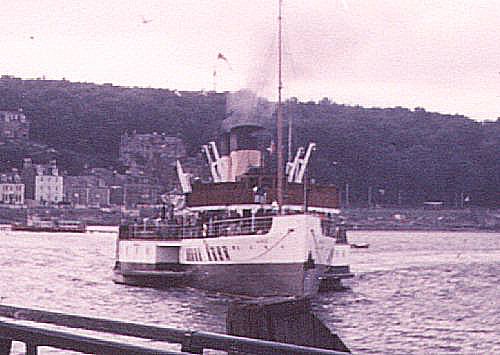
|
Paddle Steamer Waverley. Built 1947 by A&J Inglis, Portishouse, for the
London & North Eastern Railway. 240ft long, and powered by a triple-expansion
reciprocating steam engine. And like all steam-powered craft, a living, breathing creature. Here she is, coming into Rothesay Pier. Beamy, isn't she. How would you like to try docking a boat like that, with no prop wash to help you at low speeds. Easy?. Now try it in the teeth of a West Coast gale, several times a day. Takes skill. |
|
And now she waits for us to come on board at Rothesay Pier. We can't help noticing the streaks of rust, and surely the funnels shouldn't be smoking like that, but look at the line of that bow - all the neglect in the world can't mask her beauty. Let's get aboard. |
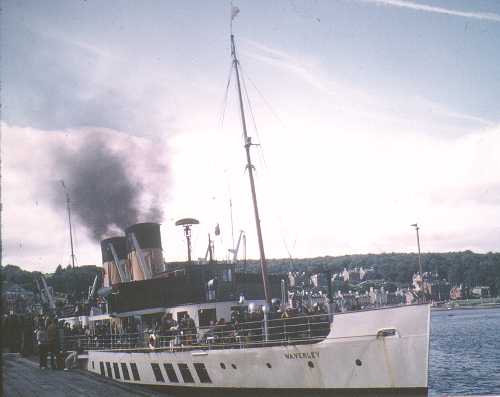
|

|
The Clyde is a lovely area to cruise, particularly on a day like this,
but it can get a bit cool on deck. Afficionados usually try to get a seat aft of the funnels, since this is where the engine room ventilators belch warm steam-flavoured air. On a brisk day, it can make all the difference.... You can hear the gentle sounds of the engines from here, too. For those who know only the roar and vibration of marine diesels, steam power can come as a pleasant surprise. Waverley has a triple-expansion engine, which means that she has three cylinders - the sound she makes is in Waltz time.. |
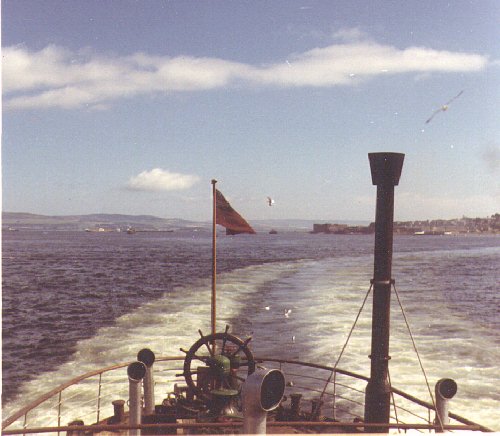
|
Now there's a sight you'll only see on a Paddle Steamer (a sidewheeler,
for our American friends) - two wakes, one from each paddle. We're thundering away from Gourock in the picture, heading down the Firth of Clyde. In the background, you can see Prince's Pier, Greenock. (The ships's wheel you see in the picture is an emergency backup, by the way. Waverley is no different from any other ship: she's steered from the bridge.) |
|
And this is what makes her go. Waverley's engine. One of the many charms of the Clyde Steamers was the openness of the Engine room. On the paddle steamers there was nothing between you and the engines but a guard rail. As a child (and as an adult) my first stop was always to 'visit the engines'. I'd have stayed there all day if they'd let me. You could lean over and see the whole engine, all the valves and pistons and oilers and, well, stuff. It was great. |

|
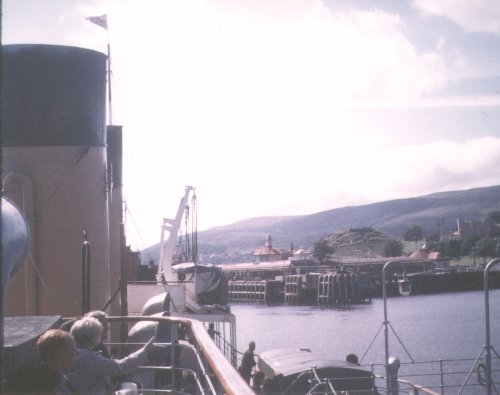
|
Approaching Dunoon pier. Never liked the place much as a kid - much preferred
Rothesay. There was more to do, somehow. The pier is quite attractive, though,
and the town has the faded gentility of most Clyde Coast resorts. Probably the sort of place Presbyterian ministers retire to. |
|
Finally, we reach our destination, Largs. One of my favourite towns
on the Clyde. Look at the colour of that water. Paddle steamers, like any other boat, (and some drivers I've met) stop by putting their engine in reverse. The result is that amazing green champagne effect, as the paddles churn the sea into a foam. Paddles don't cavitate, as such, but they can make quite a fuss. Right. That was our trip on Waverley, back in the early Seventies. Thanks for joining me. Now I'm off to Nardini's for some of their excellent ice cream. |
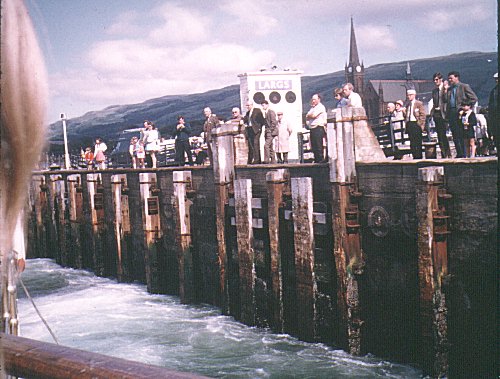
|
